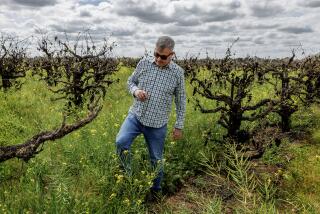And in California, the green treasureâs in season
TO most of our minds, top quality olive oil is foreign, usually Italian, with names that sound like they could be a food, or the title of some ultra-worldly count. Badia a Coltibuono and all that. But behind their names and their confusing grades (pure, virgin, extra virgin) is a simple fact: Olives are fruit. Olive oil is nothing more complicated than fresh fruit juice, except that we garnish and cook with it instead of drink it.
Like all freshly squeezed juice, the most important determinant of quality isnât exotic provenance. Itâs freshness. On the tongue, freshness tastes like flowers, herbs and grass. Itâs sharp, immediate. Itâs as emphatic as a garnish as a shot of lemon, but a whole lot meatier.
Right now, olive oil so fresh that it outshines whatever you put it on is being made at more than 100 California ranches. The harvest started in November and is in full swing now. Oil producers will be picking their trees, pressing and bottling the 2002-03 season oil through February.
Chris Banthien, 2001 winner of the best in show for her Le Colline di Santa Cruz Olive Oil, made in Aptos, is bottling her new season oil this minute. She reckons that it keeps its just-picked intensity for about a month, after which itâs merely extra-virgin, cold pressed good stuff.
The problem California producers have had to date is that, quite often, their oil is not as well made as, say Count Badiaâs. Some say Italian oils are better because they start with better olives. The stateâs old groves, planted with Mission, Sevillano and Manzanillo olive trees tend to produce rich, sometimes bland oil. As a result, new wave producers, such as Banthien, have been increasingly offering greener, grassier-tasting oils made from recently planted Tuscan varieties of olives, including Frantoio, Maurino, Leccino and Pendolino.
When farmers pick their olives and press them will also affect the oil. The words âearly harvestâ usually signal a green, tangy oil and late harvest a riper, golden one.
Some say the state needs fiercer policing and certification. Oil can be fusty or musty. If left in heaps before pressing, olives can ferment -- like fruit -- and their juice can be rank. California now has an impressive panel of expert tasters trained to sniff out this sort of defect. Any bottle bearing the seal of the California Olive Oil Council will have passed the muster of this set of bloodhounds, but small producers, even ones making great oil, often donât bother with this.
The thing you should look for, particularly when buying oil in a store, is a date. Not all California producers give them. The Santa Cruz olive oil producer Balzana is an honorable exception. Its new season oil should be in Los Angeles shops early next year. If you see it, buy it. Itâs a fine oil.
The most satisfying way to taste new season oil is buying it direct from the farmer, or olive press. In Northern California, a number of olive presses are open to the public.
In Southern California, you can order it online or go to farmers markets. Pasolivo, an Italian-style oil made in Paso Robles, has been offering last yearâs oil in Torrance and Palos Verdes for $16 for 500 milliliters, and it was good. New stuff should be arriving in farmers markets in late January. Ron Asquith recently started selling brand-new Ojai Olive Oil for $15 for 375 milliliter bottles at Ojai farmers market. They wonât fit in your cabinet. The blue bottles are too tall, but if youâre using it right, you shouldnât need to. You should run out before it has a chance to age much.
Rule No. 1 for any good olive oil -- not the supermarket $5.99 âextra virginâ kind, but the stuff that costs the same as good wine and comes in bottles fit for bath salts -- is to buy small amounts often.
Use it fast. Pour it over bean soup, on bread, salad, vegetables, potatoes or grilled fish. Put it over bresaola, salami, even cheese. When you make a sandwich, forget mayo and mustard, use oil and vinegar. Of course, put it on pasta.
For the brief time that it should take you to use it up, store it in a cool dark cabinet. Roberto Zecca, proprietor of Frantoio restaurant and olive press in Mill Valley, even advises keeping olive oil in the fridge, as one would any fruit juice, though the oil needs to warm before being used.
No olive oil should be stored in a sunny, warm spot or at the rear of the stove, unless you want that buttery, rancid taste.
Here are some locally made fresh olive oils, and where to find them:
Olio del Le Colline di Santa Cruz is available mail order, $27.50 plus shipping for 500 milliliters. (831) 662 2345; e-mail [email protected].
Balzana Olive Oil, 2001-02, available at Wallyâs, Beverly Hills Cheese Shop, Bristol Farms, Sufras, Cookeâs Market in Malibu. 500 milliliters, by mail order $20 including postage, (800) 815-9775. New oil available starting in February.
First vintage Ojai Olive Oil, $15 for 375 milliliters, available at the Sunday morning Ojai farmers market or direct from Ojai Olive Oil Co., (805) 646-5964; e-mail [email protected].
Pasolivo, Willow Creek Olive Ranch, 8530 Vineyard Drive, Paso Robles, (805) 227 0186; e-mail info@willowcreekolive ranch.com
Olive presses open to the public include:
The Olive Press, Jack London Village, 14301 Arnold Drive, Glen Ellen, 95442, (800) 965-4839 or [email protected]
Frantoio Ristorante and Olive Oil Co. 152 Shoreline Highway, Mill Valley, 94941, (415) 289-5777, www.frantoio.com/.
Pietra Santa Vineyard & Winery, 10034 Cienega Road, Hollister, 95023 (831) 636-1991, Ext. 201; www.pietrasanta winery.com.
To find a grower near you, and information about all matters olive, go to www.oliveoilsource.com/ and click on industry.
*
Fresh vegetable soup (zuppa di verdure)
Total time: 1 hour, 45 minutes, plus 8 hours soaking
Servings: 10
Note: At Vincenti, this soup is finished with a drizzle of Manni olive oil. Dried borlotti beans (also known as cranberry beans) are called for, but 1 (15-ounce) can of white beans can be substituted. Drain them before adding to the soup.
About 2 tablespoons extra-virgin olive oil
3 carrots, diced
3 small baking potatoes, peeled and diced
1 large onion, diced
2 stalks celery, diced
2 leeks, green tops removed, sliced
1 cup diced cabbage
1/4 cup fresh or frozen peas
1 cup green beans, cut into 1/4-inch pieces
2 zucchini, diced
1 cup dried borlotti beans, soaked overnight, drained
2 tomatoes, seeded and diced
1 cup lightly packed spinach
8 cups hot vegetable broth
Salt
1 teaspoon best-quality, fruity, extra-virgin olive oil
1. Heat the olive oil in a soup pot over medium heat. Add the carrots, potatoes, onion and celery and cook 2 minutes. Add the leeks, cabbage, peas and green beans and cook 2 minutes. Add the zucchini, borlotti beans, tomatoes and spinach and cook until the vegetables are heated through, 2 minutes. Add the broth, cover, and simmer 1 hour. Remove any foam that rises to the top of the pot. Add salt to taste.
2. Ladle the soup into bowls and top each serving with a drizzle of the olive oil.
Each serving: 205 calories; 790 mg. sodium; 2 mg. cholesterol; 5 grams fat; 1 gram saturated fat; 33 grams carbohydrates; 8 grams protein; 7.79 grams fiber.
More to Read
Eat your way across L.A.
Get our weekly Tasting Notes newsletter for reviews, news and more.
You may occasionally receive promotional content from the Los Angeles Times.










